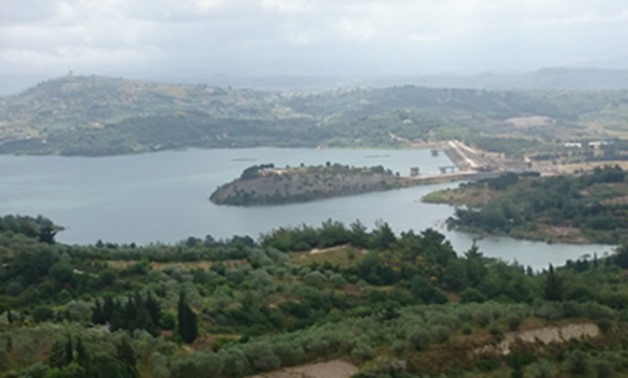
Panoramic view of Ayn al-Bayda in the countryside of Latakia, Syria, by Jadd Haidar. Courtesy: Creative Commons via Wikimedia
CAIRO – 25 September 2017: Ibn Battuta once said, “If Paradise be on this earth, Damascus it is and none but she; If in the heavens, from her derives its air and its amenity. ‘Fair city and forgiving Lord!’ Enjoy her – swift the hours will flee!
Ibn Battuta, the renowned Muslim jurist by profession in the 14th century AD from Tangier, Morocco. Aged 20, he set out with the intention of Holy pilgrimage to Mecca in 1325 AD. This first journey arose such strong curiosity in him that he kept on travelling for 24 years straight, covering 75,000 miles (compared with 15000 miles of Marco Polo). His memoirs, The Travels, filled with local anecdotes, are a great read as they provide very accurate description of a local’s life in these areas at that time. The information in this article has been taken from a translated and annotated version. (Gibb H. A., 1958)
When we Google ‘Syria’, all we see is destruction of the worst kind, which only humans are capable of inflicting.
Ibn Battuta reached Syria during the prosperous Mamluk Sultanate (1250 – 1382 AD). Saladin’s efforts in the 12th century had left this area stable and united, a base on which the Ayyubids and the Mamluks were able to build a peaceful state. Battuta had started from Cairo the previous month and had visited cities like Gaza, Jerusalem, Hebron along the way. He wanted to catch one of the state supported pilgrimage caravans from Damascus to Mecca.
Hama
 1: Hama, Syria by Bernard Gagnon. Courtesy: Creative Commons via Wikimedia
1: Hama, Syria by Bernard Gagnon. Courtesy: Creative Commons via Wikimedia
In Syria, Ibn Battuta stayed in the city of Hama in July, 1326 AD. He says it is a city of “dignified metropolitan centers… of exceeding comeliness… surrounded by orchards and garden, supplied by water wheels.” His simple words paint a perfect picture of a classical desert spring, a safe haven for travelers and inhabitants alike. Some of these water wheels have survived up till now and a traveler is filled with awe at the gigantic structures used for water supply from the Orontes River. He particularly favored the “Almond Apricots”, a type of apricot which naturally contains sweet almond in its seed.
Aleppo
 2: Umayyad mosque, Aleppo. Courtesy: Unsplash
2: Umayyad mosque, Aleppo. Courtesy: Unsplash
Ibn Battuta called Aleppo a vast metropolis and describes its citadel which “has no fear of thirst” because of “two wells, fed with water from springs”. The marvelous structure was fortified by two walls with a trench in between filled with water by Saladin’s son. It is still standing today, as a shining crown on Syria’s forehead having survived two sieges from Mongols and the notorious Tamerlane in the middle ages. He says more about the architecture of the city: “It is one of the most illustrious of cities… which has no rival in beauty of plan and perfection of arrangement, and in the spaciousness and symmetrical disposition of Bazaar (markets)” which have a wood roof to provide shade. He has copied a couplet from an 11th century poet:
When for my ill no cure you find,
Fetch me a breath of Halab’s wind.
Damascus
 3: The ancient gate of Damascus. Courtesy: Pixabay
3: The ancient gate of Damascus. Courtesy: Pixabay
No other city comes close to Ibn Battua’s adoration for Damascus. He is tongue-tied and agrees with Ibn Jubayr’s brilliant comments who visited Damascus two centuries prior: “She is the Paradise of the Orient…. the seal of Islamic lands which we have explored, and the bride of the cities which we have unveiled.” Damascus was the capital of the Umayyad era, the first hereditary Muslim caliphate with kingly qualities of might and luster in the 7thcentury AD. Although the Abbasids moved the capital to Baghdad, Damascus never lost its royal shine. He visited the graves of Umm Habiba (the wife of Prophet PBUH), Bilal (Muezzin of the Prophet PBUH), Zainab (daughter of Ali bin Abi Talib) and Muawiya (the first Umayyad Caliph). He also describes a number of colleges of Damascus belonging to different sects, co-existing in peace, engaged in discussion and progress of social, political and physical sciences.
Ibn Battuta also describes the social support to citizens, “There are other endowments for supplying wedding outfits to girls whose families are unable to provide them and others for the freeing of prisoners. There are endowments for travelers… they are given food, clothing, and the expenses of conveyance. Then there are endowments for the improvement of the streets, because all the lanes in Damascus have pavements on either side, on which the foot passengers walk, while those who ride use the roadway in the center (Gibb H. A., Syria, 1958).”
 4: Archaeological teacher in old Damascus, Syria, and is one of the most beautiful old Damascus houses. By Yazan Refai. Courtesy: Creative Commons via Wikimedia.
4: Archaeological teacher in old Damascus, Syria, and is one of the most beautiful old Damascus houses. By Yazan Refai. Courtesy: Creative Commons via Wikimedia.
Of the Grand Umayyad Mosque of Damascus, he says “This is the greatest mosque on earth in point of magnificence… the most exquisite in achievement”. Caliph Walid bin Abdul Malik requested the roman emperor in Constantinople for skilled craftsmen for its construction which is a testament of support showed to art and craft by the caliph. Considered by some Muslims to be the fourth holiest place in the world, this historic mosque is still standing.
Currently, the hours of fairness seem be have indeed been flown from Damascus and Syria but there is always hope of peace and better times. May humans find it in themselves to rise above their pettiness and place humanity above all.
This article was originally published in Mvslim.com





Comments
Leave a Comment